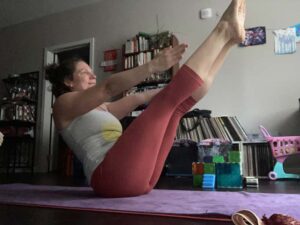My interest: yoga
 In 2001, I was a graduate assistant in Grenoble, France, with a good amount of free time on my hands. One day I saw an ad for a weekly yoga class. I’d never been athletic, but I was looking for a way to meet local people and to get outside of my comfort zone, so I signed up. That first introduction evolved into a passion for Ashtanga yoga, which I have been practicing approximately five-six days a week for the past 17 years.
In 2001, I was a graduate assistant in Grenoble, France, with a good amount of free time on my hands. One day I saw an ad for a weekly yoga class. I’d never been athletic, but I was looking for a way to meet local people and to get outside of my comfort zone, so I signed up. That first introduction evolved into a passion for Ashtanga yoga, which I have been practicing approximately five-six days a week for the past 17 years.
Ashtanga is grounded in a three-pronged method of using the breath, asana (physical postures), and dristi (gaze) to work through established series of postures. I learned it through the traditional or “Mysore” style method when I returned to Boston from my time in France. This method is basically learning and memorizing the sequence through individual instruction within the group setting. I was immediately drawn to the physical and mental challenge of the practice, as well as the sense of discipline, and the quiet of the “Mysore room” where all you hear is the breathing of the other students and the occasional verbal instruction from the teacher.
Over the years, I’ve had the opportunity to engage in a number of teacher trainings to deepen my study of yoga, and I’ve even traveled to Goa, India, to spend two weeks studying with teachers there.
While I no longer practice under the supervision of a teacher in a Mysore room, the sequences are memorized and especially conducive to home—and quarantine—practice. This style of yoga provides me a sense of grounding in my everyday life. When I’m traveling, I’ll seek out a local studio to practice. I’ve been able to practice in Mysore-style studios in cities where I didn’t speak the language such as Prague, Tel Aviv, and Lisbon. I simply unroll my mat and do the asanas that I’ve learned and plug into the breath and the vibe in the room. When there isn’t a local studio, I’ll make space to practice in my hotel room.
My interest in yoga has expanded over the years into an interest in mindfulness, meditation, the study of yoga philosophy, and Ayurveda. Over the years, my practice has provided me with a sense of equanimity in the face of stress and has been the primary way that I take care of myself so that I can show up for the people that I care about the most (my friends, family, colleagues, and my students).